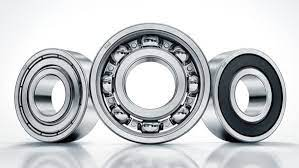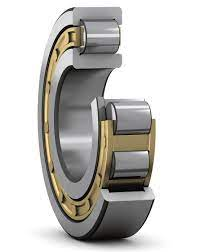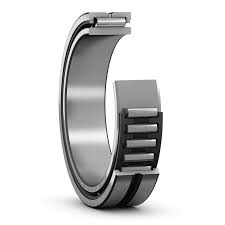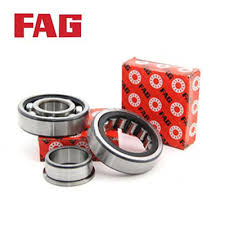FAG Bearing - What Is It? How Is It Used? Types Of FAG bearings
FAG, an acronym for "Fischer's Automatische Gusstahlkugelfabrik" or "Fischer's Automatic Steel Ball Factory," is known for developing and manufacturing high-quality rolling bearings, linear guidance systems, plain bearings, and engine components for the mechanical engineering, automotive, and aerospace industries worldwide.
The amazing idea that led to the creation of the FAG brand.
In 1883, Friedrich Fischer invented the ball-grinding machine that, for the first time, made it possible to grind steel balls that were precisely round. This invention is credited with giving rise to the entire rolling bearing business.
Do you wish to learn more about this company and its operations? Continue reading.
1.What is a FAG bearing and what are its uses

A FAG bearing is a type of rolling element bearing, meaning it helps reduce friction as two objects move relative to each other.
FAG bearings, in particular, are commonly used in automotive and industrial machinery applications for smooth rotational motion.
These bearings consist of an outer ring, inner ring, and a number of rolling elements housed within the two rings. Depending on their design, FAG bearings can handle different levels of radial and axial loads.
In addition to providing smooth and efficient operation, they also help extend the lifespan of mechanical components by reducing wear and tear.
Overall, FAG bearings are vital components in many machines and vehicles. But like any machine part, they require regular maintenance and may eventually need to be replaced to ensure proper functioning.
2. How does a FAG bearing work
The bearings enable many of the machines we use daily frequently.
Since rolling objects are easier to move than sliding ones, we would need to replace worn-out components frequently if not for bearings.
The wheels on your car look like big bearings. If your car had anything like skis in place of wheels, it would be considerably more difficult to push down the road.
Low friction between moving items tends to slow them down when it occurs.
However, friction is significantly decreased if the two surfaces can roll over one another.
By providing smooth inner and outer ring and exterior surfaces for the balls to roll against as well as smooth balls or rollers, bearings reduce friction. The device can spin smoothly because of these balls or rollers, which "carry" the weight for more accuracy.
The two forms of loading that bearings typically withstand are radial and thrust high loads. Depending on where it is used, the bearing may encounter thrust loading, radial loading, or a mix of the two.
An electric motor and pulley combination only places a radial load on the FAG bearings.
The tension in the belt connecting the pulleys is primarily responsible for the load.
Both radial and thrust stresses must be supported by the bearing in the wheel hub of your car.
The thrust load is caused by the cornering forces as you move around a turn, whereas the radial load is caused outer ring by the weight of the car.
3. Types of FAG bearings
Here are the different types of FAG bearings:
Roller bearings
By lowering friction and facilitating smooth movement, FAG tapered roller bearings increase the working conditions of wheels, pulleys, fans, pumps, compressors, and other rotating equipment.
They have a flat, wide bearing that offers stability in high-radial-load, high-speed applications, and accuracy.
Radial high loads, such as the weight supported by a pulley or wheel, apply pressure throughout the diameter (radius) of the shaft.
They move at a variety of rates. The great effective distance between the bearings makes them excellent at supporting forces and ensures a stiff and precise shaft guidance system.
Cylindrical bearings
These bearings support axial and radial loads, such as those seen on car axles where the force is applied along the wheel axis and through the wheel.

Needle roller bearings
In small spaces, needle roller bearings can withstand high radial loads and low speeds.
The raceways in these bearings feature optimum roughness and geometric precision. As a result, the service life and load-carrying ability are increased.

Deep groove ball bearings
In applications like wind turbines, pumps, paper manufacturing, and fans, where misalignment is a possibility, spherical roller bearings sustain large shock loads.
An extremely high load-carrying capacity is attained by making the most use of it because of the advancement of deep groove ball bearing for accuracy.
Tapered roller bearing
Axles and gearboxes, among other applications, require FAG tapered roller bearing cones and cups to handle heavy radial and axial loads.
They are detachable and adjustable, making attachment simple.
The shape, surfaces, dimensions, and running accuracy, as well as the material and heat treatment technique, were all adjusted to meet the demands.
4. Applications of FAG bearings
The bearing can include nearly any mechanical industry, such as robotics, lathes, tools, vehicles, heavy machinery, etc.
The majority of bearings are utilized specifically in the fields of:
-
agriculture
-
heavy machinery
-
solar panels
-
medical equipment
-
power plants
-
manufacturing
-
mining
-
conveyor rollers
-
wind turbines
-
cargo systems
-
engines
FAG bearings are employed in a variety of industries, from wind turbines to the aerospace industry.
Examples from autos, railroad cars, automobiles, industrial machinery, and aircraft all require FAG bearings. They have production sites in Brazil, the United States, Canada, Europe, and Asia.
Construction machinery, electrical engineering, hydraulic technology, power generation, steel plants, motorcycling, textile machines, pulp and paper, and many other industries are all served by the company's goods and services.

Their clients recognize the business as the most trustworthy supplier for a number of crucial applications, such as traction motors, journal roller bearings, transmission, auxiliary motors, and many more.
You have come to the right site if you are seeking FAG distributors that are the top distributor of industrial goods, so you can count on us to deliver your goods safely and to a high standard.
5. Advantages of using FAG bearings
Reduce wear and friction.
To avoid metal-to-metal contact, FAG bearings lessen wear and low friction by up to 75% in the bearing ring, rolling body, and maintainer's contact area.
Lengthen the fatigue life.
The rolling contact surface lubrication was good throughout the rotation, which extended the bearing's rolling fatigue life.
On the other hand, if the oil has a low viscosity and a poor lubricating film thickness, the process will be shortened.
It lowered running and dimensional tolerances significantly for ideal load distribution. By avoiding stress peaks, the amount of material loaded is decreased.
Cooling from friction should be released.
The heat produced by friction or by outside heat can be expelled using the circulation to oil method.
Prevent the lubricating fluid from aging and the bearing from overheating.
6. What factors to consider when choosing a FAG bearing
When selecting an FAG bearing, keep the following things in mind:
• The precision of the bearings
• Tolerance for dimensions
• Loading low speed
• Interior space
• Hardness that has been heated
• Cage design
• Content
7. How to install or replace a FAG bearing
Here is the installation process for the three different types of FAG bearings:
Installation position of FAG deep groove ball bearings
Deep groove ball bearing comes in a wide range of styles, features, numbers, and applications.
The cooperation option should be taken into consideration, and the installation process is rather straightforward.
The following formula can be used to compute the matching interference between the inner and outer rings and the journal:
△d - The degree of interference (in m) between the journal's outer diameter and the bearing's outer diameter.
d - Bearing outer diameter (mm)
B - Bearing width (mm)
R - Bearing radial load (N)
ΔT - The temperature rise difference, typically between 5 and 10 degrees Celsius, between the interior of the bearings and the edge of the housing hole.
Following computation, determine the type of fit with the shaft based on the calculated interference, and then machine the shaft to the necessary size for installed bearings.
Installation of FAG full complement needle roller bearings
Generally, auxiliary sleeves are used to install needle roller bearings with their complete complement.
The auxiliary roller and auxiliary sleeve should have an outside diameter of 0.1-0. The shaft diameter is 3mm smaller.
-
Use the auxiliary roller in place of the journal or inner and outer ring of the bearings during installation by first applying grease to the inner and outer ring surface of the bearings outer ring, pressing the needle against the inner ring surface (there should be a gap when inserting the last needle)
-
Alternatively, insert the auxiliary sleeve into the outer ring hole and align the end face with the mounting shaft's end face or the end face of the inner ring of the bearing that has been installed on the shaft.
-
In order to prevent it from falling out, the needle roller is now supported by the auxiliary roller or auxiliary sleeve, and the journal lifts it using its own chamfer. As the needle bearing steadily advances inward on the journal, the auxiliary roller or sleeve will softly retract until it is in the operating position.
-
This method of installing needle roller bearings also involves applying a thin layer of lubricating oil to the outside diameter of the auxiliary sleeve, inserting it into the outer ring of the bearing to create an annular hole, and then inserting needle rollers into the annular hole to be sealed.
-
Use the working conditions of the shaft to remove the auxiliary sleeve after inserting the needle roller.
Installation of needle roller bearings
-
Apply a little layer of oil to the rolling surface of the shaft or housing hole before placing the needles at each installation point in turn for needle roller bearings without an inner and outer ring.
-
When inserting the final needle, there ought to be a space. On the needle bearing's circumference, there should be a 0.5mm gap.
-
Squeezing the last needle in firmly will cause the bearing to become caught and unable to rotate; installing one fewer needle will result in a gap that is too great and will easily cause the bearing to roll while in use. The needle breaks after twisting.
-
Because the outer ring wall on needle roller bearings with only a stamped outer ring is so thin, it is specifically noted here that it is preferable to press in the outer ring rather than hammer it in to be sealed.
-
The hand hammer's uneven pressure application makes the outer ring of the needle roller bearing vulnerable to localized deformation and installation.
8. Tips for maintaining your FAG bearings
Dependable and inexpensive long-term FAG bearing lubrication
Using an automated lubricator, use of regulated relubrication the rolling bearing's contacts are continuously supplied with a suitable amount of new grease.
As a result, bearing life is significantly extended.
Vibration-based condition monitoring
FAG provides the Bearing Analyser III and Detector II as offline monitoring tools.
The bearings online surveillance tools including items from the budget-friendly Easy Check line, the DTECT X1 digital vibration monitors Wipro, Screen Saver, and VibroCheck bearings online monitoring tools.
Reconditioning
The expert dismounting, cleaning, and reconditioning of wheelset bearings are all included in the service, along with the labeling of each individual bearing prior to dismounting.
Any necessary bearing-specific documentation of all maintenance procedures.
9. FAQs about FAG bearings
What factors should we consider when selecting bearings?
We should keep in mind when choosing bearings the things that include the bearings' dimensions, the loading rate, the internal clearance, the amount of heat treatment, the cage design, accuracy, and the material.
Why is it important to check and maintain FAG bearings?
Mechanically moving components will malfunction and stick in a world without bearings, limiting smooth functioning.
The type of bearing, the weight it is required to sustain, and the maintenance schedule can all have an impact on bearing life.
By performing routine maintenance, bearing life can be increased and downtime can be minimized.
How long do FAG bearings last?
Most bearings should last eight to twelve years if maintained properly.
The bearing life is a concept used to represent bearing lifespans.
Its life is the age at which, in a sufficiently large population, 90% of persons will still be alive under similar circumstances.
Conclusion
Do you know what bearings do, a type of mechanical component?
In fact, they are so essential and suitable to the machine sector that they have been dubbed the sector's "bread and butter.
" They are employed in a wide variety of machines, but because they operate in secrecy, most individuals who are not employed in the machine sector probably have no idea what they mean when they hear the name.





